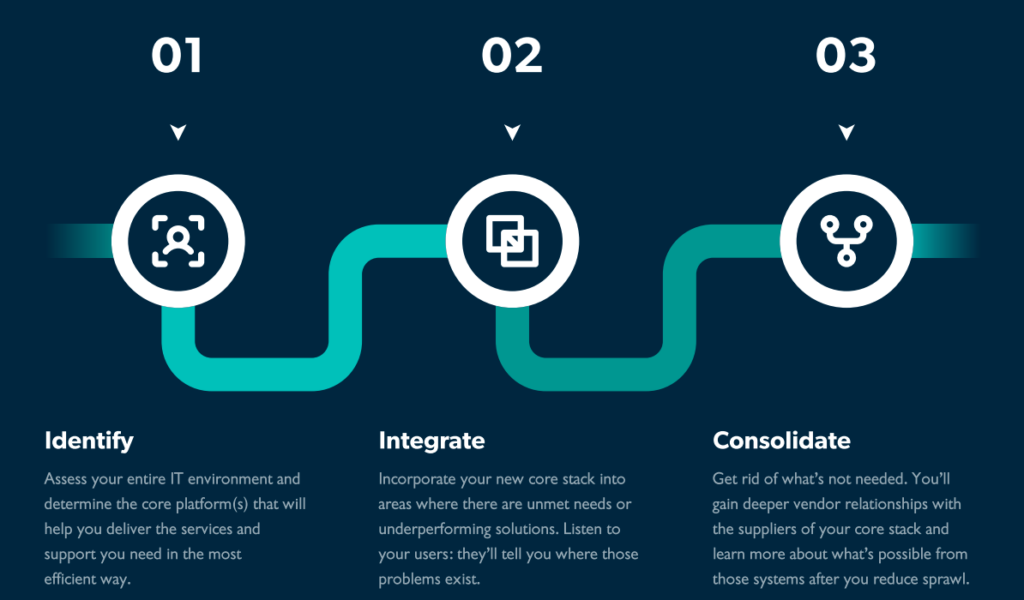Tech bloat is real. Spend any time in the SaaS industry, and this becomes clear immediately.
Experienced developers know the value of clean, modular code over functions stuffed with every possible edge case. That same principle of elegant simplicity applies to your entire tech stack. IT teams also know the struggle is real—a tech stack keeps growing, all while getting less efficient. Throw in new workplace models and SaaS app proliferation, and it's clear that when it comes to tech infrastructure, less might actually be more.
The Problem With Tech Sprawl
There was a time when adding a new tool offered an answer to your problem. Those days are long gone. The average company uses more than 100 SaaS applications, and tech sprawl is a real headache for CTOs and IT leaders.
Here's why:
- Increased costs: More tools mean more subscriptions, more training, and more resources dedicated to IT asset management (ITAM).
- Complexity: Multiple platforms make integrations a nightmare. Your team spends more time troubleshooting than innovating, especially when initiatives are siloed across the company.
- Security risks: Each additional tool introduces a potential vulnerability in your security infrastructure. The risks are real—as are the needs for inventorying assets, mitigating against risks, and tracking end-of-life (EOL) dates.
- Reduced productivity: Ironic as it may be, too many productivity tools often leads to decreases in efficiency as employees juggle multiple platforms and face learning curves with every new application.
The Minimalist Approach: A Three-Step Process
How do we tackle this? Tech minimalism.
It's not about ditching all your tools; it's about strategically streamlining your stack to maximize efficiency and future-proof your operations. Think of it as refactoring your entire tech infrastructure.
Get started with these three steps:

1. Identify
Take a hard look. What's essential? What's redundant? What's just collecting digital dust?
This audit should involve key stakeholders from across your organization to ensure you're considering all perspectives. For even more visibility, create a matrix listing all your tools and their features. You may be surprised at how much overlap exists.
2. Integrate
Once you've identified your core needs, focus on integration. Research platforms that consolidate multiple functionalities or that can integrate seamlessly with any must-have tools.
Your goal should be to create a cohesive ecosystem rather than one comprising a mix of discrete endpoint solutions. According to one recent study, over 90% of companies with a poorly integrated tech stack say the lack of integration has prevented their organizations from attaining key goals. Well-integrated tech stacks drive higher productivity compared to those with fragmented systems.
3. Consolidate
Here's where the real minimalism kicks in: Start phasing out redundant or underutilized tools. Be ruthless but strategic. Remember, the goal is to simplify without sacrificing functionality.
Tech Minimalism Next Steps
Tech minimalism is the future. Simplifying your tech stack offers more control with serious perks. Fewer tools mean fewer subscriptions and reduced overhead for management and training. Without too many tools to navigate, your team now supports a lean, agile stack that’s much easier to adapt as needs evolve.
To embrace the benefits of a streamlined stack, do the work to make it happen. The process is digestible and effective if you follow these steps:
- Start small: Don't try to overhaul your entire stack overnight. Begin with one department or function.
- Involve your team: Get buy-in from those who use the tools daily. Their insights are invaluable.
- Focus on core functionalities: Prioritize tools that cover your most critical needs.
- Perform audits regularly: Make stack assessment a regular part of your IT strategy.
- Emphasize training: Ensure your team knows how to maximize the tools you keep.
The Future is Lean
Flexibility and adaptability will be key determinants of long-term success as organizations worldwide face the increasingly dynamic IT environment. A bloated tech stack slows IT teams—and all employees—down. Embracing tech minimalism means better operational efficiency today and a more agile, efficient, and ready-to-scale organization overall.
Is your current stack serving you well or adding unnecessary complexity? If it's the latter, it might be time for some serious reworking of your digital infrastructure.
Subscribe to The CTO Club's newsletter for more tech insights, guides, and tools.




